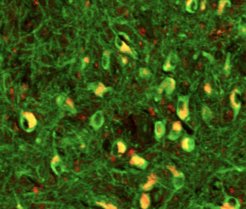Measuring metal concentrations in cells for early detection of Parkinson’s
Scientists around Malte Brammerloh and Evgeniya Kirilina from MPI CBS in Leipzig describe a new technique for measuring the magnetic properties of metals within cells in the Journal “Physical Review X”. The method is providing a powerful tool for studying how metal accumulation in cells contributes to certain diseases such as Parkinson’s and Alzheimer’s.

Metals such as iron are essential for cellular processes, but in high concentrations or in certain chemical forms they generate free radicals that lead to cellular damage. Dopaminergic neurons in the human brain, for example, use iron to synthesize the neurotransmitter dopamine, but they degenerate when cellular iron levels become too high. Measuring metal concentrations and their chemical form directly in cells is therefore critical for understanding the role of metals in cell physiology. In their paper in Physical Review X Malte Brammerloh and colleagues present a new technique for in-cell magnetometry that allows them to measure the magnetic properties of metals directly in cells and to study the chemical form of metal binding.
Using magnetic resonance imaging with microscopic resolution performed by the Jena University Hospital, the scientists measured minute magnetic field perturbations around each cell, which are induced by paramagnetic metals in the cell body. “We then used a biophysical model to determine the magnetic moments of cells based on these measurements. By comparing them with their metal content measured by ion-beam microscopy and X-ray fluorescence at our cooperation partner DESY in Hamburg, we determined the susceptibility of the metal. Using this method, we could show that iron in neuromelanin is predominantly stored in a putatively neurotoxic form of single iron ions.”, says Malte Brammerloh, first author of the study.
Evgeniya Kirilina, group leader at MPI CBS, adds: “Our method provides valuable insight into the magnetic properties of metals within cells and sheds light on their cellular chemistry. It can be used to study the role of metals in diseases associated with accumulation of metals in the body, such as Parkinson’s and Alzheimer’s disease. Our results also have the potential to enable early detection of neurodegeneration in Parkinson’s disease before the onset of motor symptoms.”












